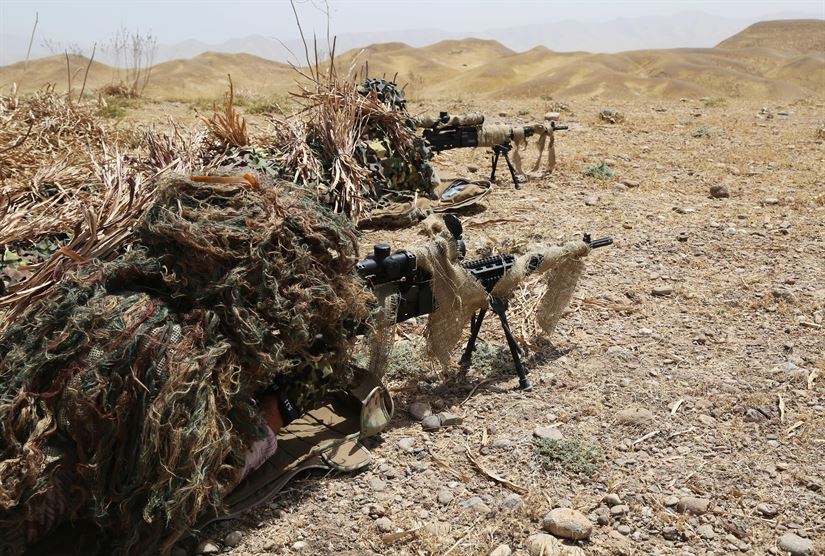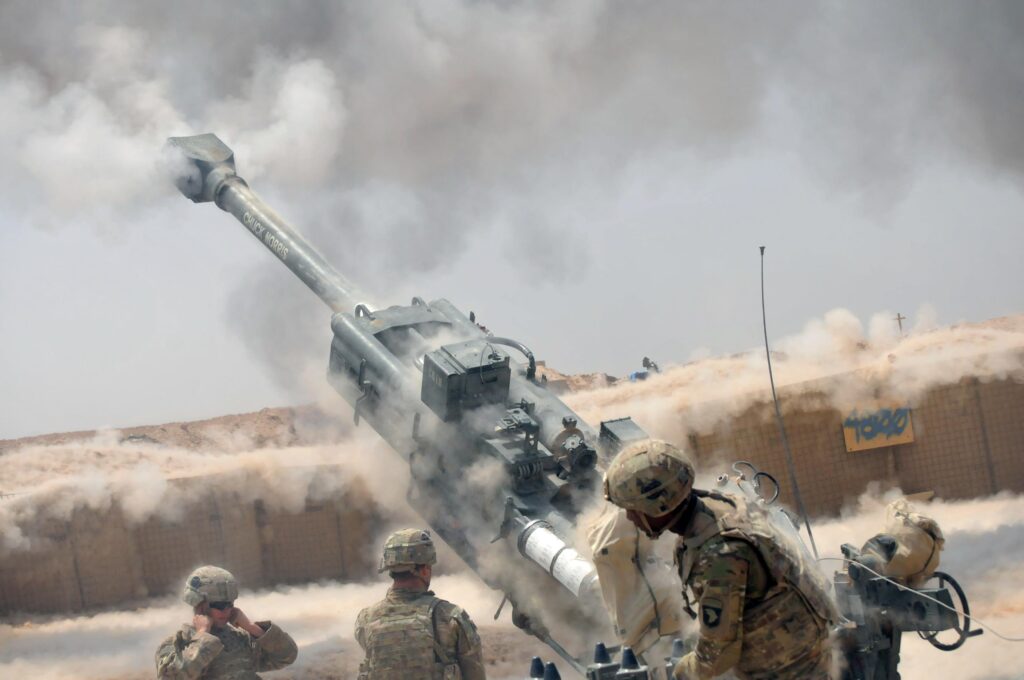Will Daesh 3.0 Rise From Mosul’s Ashes?
Posted on

Peshmerga training with M14s
They’re surrounded, targeted by constant bombardments and slowly strangled of supplies and reinforcements for months so fighters for Daesh (aka ISIS) might reasonably have abandoned Mosul and tried to slink off into the night.
That’s what happened last June in the battle to recapture Fallujah, when Daesh fighters were relatively quickly routed, and hundreds were killed by U.S. aircraft when their fleeing convoy was spotted in the dark with infrared targeting systems. Everyone in the anti-Daesh coalition hoped for a similar retreat by demoralized terrorists that would separate them from the hundreds of thousands of Iraqi civilians still cowering in Mosul’s byzantine old city, on the west bank of the Tigris River.
But Daesh’s fighters are not abandoning Mosul, which with the Syrian town of Raqqa, forms the twin-capitals of the self-proclaimed Islamist “caliphate.” They are falling back on defensive positions prepared for two years in the densely congested side streets and alleyways of the old city, gathering Iraqi civilians close as they can as “human shields” and apparently preparing for a last, desperate stand.
The result? “The toughest and most brutal phase of this war, and probably the toughest and most brutal close quarters combat that I have experienced or even read about in my 34-year career,” Army Lt. Gen. Stephen Townsend, commander of Combined Joint Task Force – Operation Inherent Resolve says. A veteran of six combat tours, Townsend calls the fighting in Mosul “the most significant urban combat since World War II.” The tragic byproduct has been an alarming spike in civilian casualties, including a U.S. strike against a reported ISIS truck bomb on March 17 that may have collapsed a nearby building and killed as many as 200 civilians gathered there by Daesh. The U.S. military is still investigating the incident, which drew criticism from the United Nations and Amnesty International.
On a recent trip near the frontlines of the Battle of Mosul, Townsend found a possible explanation for Daesh’s determination to stage an apocalyptic fight to the death in the old city. “Every movement has a well-spring or some home turf where it finds support, and in recently talking to Iraqi and coalition commanders and listening to their intelligence assessments, I heard about neighborhoods supporting ISIS that I remembered from being a brigade commander in Mosul 10 years ago, when those same neighborhoods were sources of support for Al Qaeda in Iraq,” said Townsend, speaking recently to defense reporters by phone from Baghdad. If the Shiite-led Iraqi government fails to reach out to those and other neighborhoods and towns of disenfranchised Sunnis after the fighting stops, he noted, then Daesh’s expulsion from Mosul will likely prove a fleeting victory. “What’s important after ISIS is defeated is that the government of Iraq has to reach out to these groups of people and make sure they feel like they have a future in the Iraqi state,” said Townsend.
A Pivotal Moment
 With roughly three-quarters of Mosul recaptured and Daesh finally on the verge of losing its grip on Iraqi territory, the campaign against them is poised at an important inflection point. Counter-insurgency experts have long understood that the actions of the Iraqi government and the various factions involved in the fighting the day after Mosul is recaptured will largely determine whether the group is defeated, or, once again, rises from the ashes of sectarian conflict.
With roughly three-quarters of Mosul recaptured and Daesh finally on the verge of losing its grip on Iraqi territory, the campaign against them is poised at an important inflection point. Counter-insurgency experts have long understood that the actions of the Iraqi government and the various factions involved in the fighting the day after Mosul is recaptured will largely determine whether the group is defeated, or, once again, rises from the ashes of sectarian conflict.
The complex nature of the battlespace, combined with the anti-Daesh coalition’s sprawling nature, promises to complicate the transition from urban combat to whatever comes after. The Shiite-led government of Prime Minister Haider al-Abadi is weak and has struggled to cope with the demands of hundreds of thousands of refugees from the fighting in Mosul. The territorial demands of Kurdish Peshmerga fighters to the north, and possible acts of retribution against Sunni civilians by thousands of Iranian-backed Shiite militiamen to the west of city, cast a dark shadow over the aftermath. A continued spike in civilian deaths by U.S. and coalition air forces could further alienate the overwhelmingly Sunni population of Mosul and surrounding Nineveh Province.
And hanging over the entire anti-Daesh campaign is the question of a continued U.S. presence in Iraq after the group is expelled, and whether that engagement can be leveraged to help achieve the long-sought national reconciliation among Iraq’s feuding Kurdish, Shiite and Sunni factions.
Perhaps no U.S. military officer of his generation better understands this difficult terrain, and the momentous challenges ahead, than retired Gen. David Petraeus, the former top U.S. commander in both Iraq and Afghanistan and at U.S. Central Command. He is widely credited with crafting and executing the counterinsurgency doctrine that pulled Iraq back from the abyss of sectarian civil war in 2007-2008 and decimated Al Qaeda in Iraq. “The military defeat of ISIS is only the first step. The much more challenging task is to use all elements of American and coalition power to help achieve political solutions that will avoid once again creating fertile ground for extremists, and thereby avoid the rise of ISIS 3.0,” Petraeus told me in a recent email. “Our success in that mission will determine whether the U.S. military has to do this all over again in five years.”
Sectarian Civil War
After U.S. and Iraqi military forces and the Sunni tribes of Anbar Province routed Al Qaeda in Iraq (AQI) beginning in 2006-7, the remnants of the terrorist insurgency eventually went underground, only to rise Phoenix-like from the fires of Syria’s civil war. That brutal conflict pitted a minority regime of Alawites, which is an offshoot of Shiite Islam, against a majority Sunni population. Meanwhile, after the withdrawal of all U.S. forces from Iraq in 2011, the Sunni tribes in western Iraq which had turned against AQI in the “Anbar Awakening” grew restive under the iron-fisted and openly sectarian rule of former Prime Minister Nouri al-Maliki, who headed the Shiite-majority government in Baghdad.
A former AQI lieutenant named Abu Bakr al-Baghdadi, who had spent time in a U.S. detention facility in Iraq, realized that between weak Shiite-led governments in Damascus and Baghdad lay a swath of territory inhabited by millions of rebellious Sunnis. From that strategic insight the Islamic State of Iraq and Syria (ISIS) was born, and in one of the most improbable military offenses in history its terrorist army captured territory in Syria and Iraq and proclaimed a “caliphate” in land stretching between its twin capitals.
When the Obama administration reluctantly deployed aircraft and troops back to Iraq to defend a Baghdad government on the verge of collapse, it wisely used that leverage to help nudge out the sectarian Maliki and encourage the more moderate Abadi. Since then Abadi has promised to lead “national reconciliation” by reaching out to Sunnis liberated from Daesh rule, and draw them back inside the government tent. He has often struggled, however, to control a fractious coalition government with many hardline Shiite politicians with close ties to Shiite Iran.
Kenneth Pollack, a senior fellow at the Brookings Institution’s Center for Middle East Policy and former senior Middle Eastern analyst for the CIA, worries about Abadi’s ability to bring the country together. “I think Abadi is a very good man who wants what’s best for Iraq, to include a pluralist government, corruption reforms and democracy. The problem is Abadi is not particularly good at building coalitions, and the Iraqi government is fragmented and paralyzed by this ongoing sectarian civil war,” he says. “Frankly, Nelson Mandela would have a hard time stabilizing Iraq at this point. So the United States needs to leverage the influence it has gained by helping fight ISIS to empower Abadi in his reconciliation efforts. And they must include limiting the activities of the Shiite militias.”
Reining in Militias
The key to Iraq’s future may lie with the Shiite-dominated militias called Popular Mobilization forces. A number of these militias have direct links to Iran and they have been difficult for the Iraqi government to control. According to Human Rights Watch, Shiite militias involved in the battle of Fallujah last summer committed atrocities against Sunni civilians, including torture and summary executions. In the operation to recapture Tikrit they reportedly burned hundreds of homes of Sunni civilians they accused of colluding with Daesh. If something similar happens after Daesh is expelled from the much bigger and more populous city of Mosul, the swamp of Sunni grievance is likely to rise once again.
Sheikh Jamal Al-Dhari is a Sunni tribal leader who has lost more than 70 family members in Iraq’s sectarian wars. “The ‘Anbar Awakening’ showed that the way to defeat Al Qaeda is to work with the Sunni tribes, but our efforts to take part in the anti-ISIS fight have been repeatedly rebuffed by the Baghdad government,” he said in an interview. Now Shiite-dominated Iraqi Security Forces and possibly U.S. airpower have inadvertently killed hundreds if not thousands of Sunni civilians in Mosul, he noted, and thousands of Shiite militiamen have captured Sunni majority villages to the west of the city. “We fear that the use of excessive force will cost the lives of thousands of more civilians, creating hardships and hard feelings that will only set the stage for the next ISIS, or worse.”
To avoid Kurdish or Shiite forces fighting each other and mistreating liberated Sunni civilians, U.S. battle planners created separate corridors into the city. “The U.S. military worked very hard to insure that neither the Peshmerga nor the Popular Mobilization forces would be involved in the close-in fight in Mosul, and that has been mostly successful,” said Michael Knights, an Iraq expert and fellow at the Washington Institute for Near East Studies. But the Iraqi Security Forces leading the fight have suffered a lot of casualties and are very tired, he noted, possibly causing them to rely on more firepower to limit their losses. “But the main reason we’ve seen civilian casualties increase is that ISIS is being much more aggressive in using civilians as human shields. Their backs are now against the wall in Mosul’s old city, and they seem to be preparing for a last stand.”
When the dust of battle finally settles over Mosul, the most important decision confronting the Trump administration will be whether or not to keep a residual U.S. force inside Iraq to continue advising and assisting Iraqi Security Forces, and helping coordinate counterterrorism operations. If the U.S. military packs up lock-stock-and-barrel and leaves once again, many experts believe it will only set the stage for “son of ISIS” to fill the vacuum.
“Only if U.S. forces remain in Iraq to secure the peace will we achieve a major military victory over ISIS,” said James Jeffrey, former U.S. ambassador to Iraq. The U.S. can leverage that presence not only to empower Abadi’s national reconciliation agenda, he said, but also to eventually find a political resolution to the Syrian civil war. In “On War” [Carl von] “Clausewitz said that the art of war was using tactical victories to achieve strategic ends,” said Jeffrey. “We need to use the victories in Mosul and Raqqa to achieve the strategic end of a stable Middle East that is not dominated either by ISIS or Iran.”
Subscribe to our newsletter
Promotions, new products and sales. Directly to your inbox.
